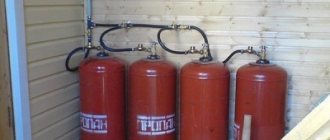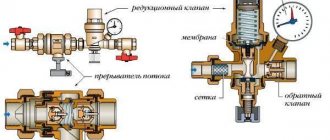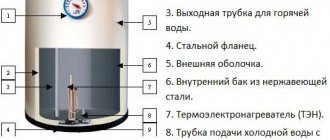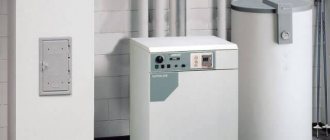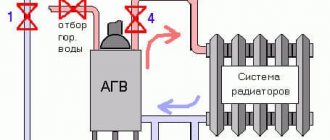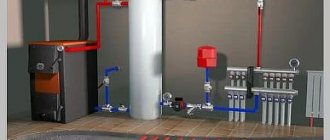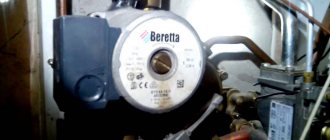The AGV boiler is a simple, but quite reliable and efficient heating device. The units have been produced since Soviet times, the products were called the Zhukovsky Machine-Building Plant. However, gradually all domestic autonomous gas devices began to be called by such an abbreviation.
Design and operating principle of AGV boilers
The unit is a non-volatile device. The equipment has a simple design, which includes:
- tank made of galvanized steel (devices are marked according to the volume of the tank);
- heat exchanger;
- burner;
- igniter;
- automation.
All AGVs are floor-standing boilers.
The device is a tank filled with water, inside of which there is a flame pipe. When gas burns, heat is transferred through the latter to the liquid. The resulting products are discharged outside the room through a chimney connected to this device. The water heats up and increases in volume - it becomes a coolant, which, in accordance with the laws of physics, rises through a specially designed distribution pipeline. From there, the liquid flows to the radiators and transfers heat to them, which is used to heat the room. When the water cools, it returns to the boiler through the return line. The cycle repeats itself again.
The AGV does not have a circulation pump and a turbofan. The nodes do not depend on the availability of electricity. Water circulation occurs exclusively by gravity, due to the difference in height between the heating tank and the radiators. Moreover, a closed cycle has been created.
Advantages and disadvantages
The advantages of boilers include:
- low cost of equipment compared to other foreign and domestic analogues;
- simplicity of design, which increases the reliability of the device;
- energy independence - such boilers can be installed even where it is not possible to ensure a stable supply of electricity;
- compactness.
However, AGVs are not without their drawbacks. Not the most durable materials are used for their manufacture. Although galvanized steel resists corrosion, its performance characteristics are inferior to modern alloys.
Even improved AGV models inherited the shortcomings of their predecessors. This is indicated in the operating instructions - until the water warms up to a temperature of +30 ºC, condensation may drip onto the burner.
What is the difference between AGV and AOGV
The autonomous heating gas water heater is a 1-circuit independent boiler. The main difference from the AGV is that the device is considered more reliable and safe to use. The unit is equipped with advanced automation.
To install AGV, a separate room is required, since combustion air is taken directly from the room. Good sound insulation is necessary, because when the device is turned on, a loud bang is heard. In AOGV this drawback has been eliminated.
When the water reaches its maximum temperature, the burner switches to minimum flame mode, but does not turn off completely. A separate room for the AOGV is also not required, since a chimney with a size of 140 mm or more is laid through the wall, and the air is taken from outside. It is only important to install a special garbage container under the pipe for waste that accidentally ends up in the channel.
Operational safety
Definitely, everything related to fire raises questions about the safety of using this or that technology in everyday life. So how to choose AGV heating in this regard, based on the fact that here we are talking about burning gas right in our home?
The gas heating system has been used everywhere and without complaints for decades. However, as mentioned earlier, progress does not stand still. The safety system of gas water heating devices is constantly being improved. To date, this technology is the safest and most effective.
AGV installation diagram
Such a high degree of safety is achieved by introducing various pressure and temperature sensors into the system, as well as draft sensors in the built-in ventilation system. This way, a violation of the operation of a particular structure or element will be instantly detected, and the operation of the unit will automatically stop. Moreover, the heating system will not work until the problems are corrected.
Do not forget that personal interference with the operation or design of the water heater is not allowed!
Installation, installation, technical condition monitoring and repair of AGVs are carried out by specialized authorized organizations that operate in each city. The prices for the services of such organizations are very affordable, especially if you take into account the cost of the unit itself and the low gasification tariffs.
Connection system
Before choosing AGV heating, please note that its installation and operation require strict compliance with all established SNIP heating standards. This will be monitored by specialists from the gas industry. They will install the system equipment only in a separate room designated for AGW. And this is not a whim, but one of the basic safety rules.
Modern heating AGV
Compared to Soviet models, manufactured devices have become convenient and functional. They are equipped with automation, which makes the operation of the boilers comfortable for the user.
Modern models have a temperature sensor necessary to control the set temperature. Often a component is installed that regulates the draft in the chimney. The operation of the automation is carried out due to the electric current generated by a thermocouple. The latter produces it due to heating. This ensures the activity of the electromagnet, which makes it possible to control the gas valve. This also increases operational reliability.
To choose a suitable model, take into account the characteristics of the equipment.
Modern AGVs are turned on using piezo ignition, which is more convenient than before. The automation used is mainly American, and the thermometers are Italian. New coating technologies have helped achieve attractive cabinet finishes.
Generation of new AGV systems
Some units are produced at Russian factories. One of them is AOGV-23.2-1, which structurally looks like a household heating cylinder. It is used in houses with an area of 140-200 square meters. There is a unit with a lower heating power - approximately 100-140 square meters. Apart from power, these two devices are no different from each other.
Recently, a new system was released called AKGV (Combined Gas Water Heating Apparatus). According to the method of use, it is no different from AGV; it is used both for heating the house and for supplying hot water. But the design of the AKGV unit is different - instead of a pipe that goes inside the boiler, three steel sections are installed, which are stamped in a special way, they are mounted in a vertical position and connected into one chimney.
This device is rightly called “two in one”, because it initially heats the water using a coil, which is encircled along the entire contour of the boiler. The water flowing through the coil is used for domestic purposes, and in the boiler the water is heated for heating.
The newest models have an injection burner. It ensures gas combustion without residue and works even when the gas pressure drops.
Automation of the new AGV
This irreplaceable item fully controls water heating and consists of:
- Thermal sensor, which gives the system an idea of the current temperature;
- Electromagnet - valve control device;
- Thermocouples, which are installed next to the igniter and are responsible for generating electric current when heated from the torch;
- Traction sensor. It is installed in the chimney to control draft.
With proper adjustment, the automation unit will prevent sudden shutdown of the AOGV in the event of a breakdown or failure in the boiler settings, and most importantly, will extend its service life.
If we talk about the origins, this type of heating equipment was developed back in the 50s, due to the lack of central heating in villages, villages and small towns. Since then, AGVs began to systematically gain popularity, and soon most houses in the USSR began to be heated with them. Thus, this system, of course, after modernization and modifications, fits well into modern realities. It is only important to know how to choose AGV heating, remember the rules for handling this system and follow them, then the boiler will serve you much longer than its declared service life. After all, the system in which hot water circulates does not tolerate jokes and amateur activities.
In general, this system is quite economical both in terms of funds and in terms of space occupied. And with the introduction of ACS (Automated Control Systems), its operation and maintenance does not cause any trouble at all. After proper setup, according to the instructions or with the help of a specialist, the coefficient of intervention on your part becomes minimal and guarantees warmth to your home.
User manual
The main thing to remember is that such boilers do not have a built-in circulation pump. Good natural traction is required. This is only possible if ventilation is established in the room where the AGV is installed, and the chimney is arranged according to all the rules.
The installation features are as follows:
- the height of the air duct is at least 5 m with a total length of horizontal sections of up to 3 m;
- the diameter of the pipe corresponds to the size of the outlet pipe of the device;
- equipment must not be connected to exhaust ventilation ducts;
- a small hatch is installed under the vertical part of the chimney to clean the system from condensate;
- When installing the AGV, you need to make sure that there is a free passage of at least 1 m in front of the device.
The recommended distance from the unit to the nearest wall is 2 m or more; this is the only way to ensure fire safety. The finishing of the vertical surface must be made of non-combustible material. If the owner doubts its properties, it is better to install a screen made of sheet asbestos.
Installation of AGV necessarily involves connecting the equipment to gas networks. You cannot do this on your own; you need to contact specialists from a company that has a license to carry out the work.
As for the operating rules, the equipment is started in the following sequence:
- First you need to check whether the heater tank is filled with water.
- Then they look for the presence of draft in the chimney. This can be done using a thin paper flag. If there is no traction, it will remain motionless. This is important because there is a risk of poisoning from unburned fuel.
- Open the valve mounted on the gas pipeline.
- Light the burner (with a match or piezo ignition handle - depending on what type is provided on the model). Then only the igniter turns on. After this, you can open the tap in front of the main burner. It should work from the igniter. It is recommended to read the instructions first.
- After turning on the AGV, check again for the presence of draft in the chimney.
- Close the firebox door.
If the igniter goes out, it can only be re-ignited after a few minutes. When the water heater is running, it should be on constantly.
The AGV is also switched off sequentially. First you need to close the gas valves. They are installed in front of the main burner and appliance. In the AGV-120 model, the pilot valves and those in front of the boiler are closed separately.
The units do not require special care. The main thing is to provide protection from mechanical damage and liquid ingress if the device is installed in such a way that splashes from a shower stall or water tap reach it.
The operation of the device should be monitored. The flame has a bluish tint and the length of the tongues is 30-40 mm. If it starts to smoke, you need to open the windows slightly to allow oxygen to enter the system. When you smell gas in the air, call specialists immediately. Before the emergency team arrives, turn off the tap in front of the equipment and ventilate the room. At the same time, turn off electrical appliances and lights so that there is no spark anywhere.
AOGV Zhukovsky Machine-Building Plant
So that the equipment is not simply confused with boilers, in recent years the name of the series has been added to the abbreviations - “Economy”, “Universal”, “Beetle”, “Comfort”.
The Zhukovsky plant produces floor-standing gas boilers, single-circuit (for heating only) and double-circuit (with hot water preparation). Many models are non-volatile - equipped with automation that does not require power supply (imported or domestic). Regardless of the automation, the manufacturer allows you to leave a running boiler unattended for no more than a day. All models can operate both in open and closed heating systems. There are also models for heating systems with natural circulation.
Models of heating boilers of the Zhukovsky Machine-Building Plant
Compared to imported units of similar power, AGV and AOGV of the Zhukovsky plant have lower prices. But first you need to look at the package. To work in systems with forced circulation, it will be necessary to purchase a circulation pump; in a closed type system, an expansion tank will be required. And a security team wouldn't hurt either. All these devices are missing in most models, since they can work in different systems (open/closed or gravity/forced), and these devices are not needed in them.
If we talk about AGV boilers with the ability to prepare hot water, they are not very productive. You will be able to wash the dishes, and you will also be able to quickly take a warm shower. But soaking under streams of hot water for 20 minutes is no longer possible... there won’t be enough heated water. If you often need hot water in large volumes, it is better to install a boiler with a combined type storage boiler (with the ability to reheat the water using a heating element).
All AGV boilers are equipped with non-volatile automation. Somewhere there is an Italian one, somewhere a German one, somewhere a Russian one from the Zhukovsky plant. All boilers use water as a coolant; the use of special antifreeze (for heating) is allowed. Efficiency in heating mode is 86%, in water heating mode - 80%. Working pressure - 1 Bar (100 kPa).
Double-circuit boiler from Zhukovsky Machine-Building Plant (article 405000) with Italian automatic equipment. The boiler is designed to heat a house up to 150 m²
Comfort line - AOGV (heating) and AKGV (with heated water)
Russian-made heating boilers AGKV Comfort (with hot water heating) and AOGV Comfort are non-volatile floor-standing gas boilers. In cross section they have the shape of a circle. Equipped with steel heat exchangers and piezo ignition. Powered by natural or liquefied gas. To change the fuel, you need to replace the burner, as well as make adjustments (a detailed description of the process is in the operating manual, it’s easy to do).
Line of Comfort heating water boilers AGV Zhukovsky plant
In terms of power, they have the same gradation as the previous line (from 100 sq. m of heated area to 300 sq. m.). Plus there are two more new boilers KOV-SG-43 Comfort and KOV-SG-50 Comfort. They are designed for heating areas from 350 square meters to 450 square meters. m. Additionally equipped with a draft and overheating sensor.
The thermal power of the burner of the KOV-SG-50 COMFORT boiler (article 425000) is 50 kW, heating an area of up to 430 m²
AKGV and AOGV Comfort boilers can operate in closed systems. A safety valve with an operating limit of 1.8 Bar and an operating pressure of 1.5 Bar (at a temperature of 60-80°C, overheating is unacceptable) must be installed at the boiler outlet. It is also necessary to install a pressure gauge to control the pressure.
Automation can be installed Italian or German. In any case, it does not require power supply (non-volatile). Automation unit AOGV and AKGV Comfort - electromechanical. Controls the pilot flame, draft in the chimney, gas pressure, and an increase in coolant temperature above 93°C.
High power Comfort boilers with technical characteristics
The coolant temperature is set by turning the switch. The adjustment limits are from 40° to 90°C, the maximum water heating in AOGV Comfort models is 60°C. During operation, the automation smoothly regulates the burner power in the range of 60-100% depending on the temperature of the coolant. When the temperature approaches the set temperature, the burner is switched to the “small flame” mode; when reached, it goes out completely (the igniter remains on). When the coolant temperature drops (by no more than 15°C), the main burner lights up again and the cycle repeats.
BEETLE series (also called Comfort square)
This is a new line with a new design - a series of floor-standing gas boilers has a square cross-section, the chimney outlet is on top, closer to the rear wall. In terms of their characteristics and other properties, they repeat the line described above, only the body is not cylindrical, but in the form of a parallelepiped. This design is more practical; the body can be “pressed” against the wall.
Power can be selected for houses of various sizes:
- AOGV and AKGV Zhuk 11.6 - 11.6 kW (the declared heated area is from 80 to 110 sq.m., if there is no insulation, it is better to take 60-90 square meters, it replenishes 9600 W of heat loss);
- AOGV and AKGV Zhuk 17.4 - 17.4 kW (for an area of 100-150 sq. m with average insulation);
- AOGV and AKGV Zhuk 23.2 kW (for a square area of 180-200 sq. m);
- AOGV and AKGV Zhuk 29 kW (for houses with an area of 200-250 sq.m.).
Square boilers AGV 11.6; 17.4; 23.6 ZhMZ
Burner type - open type (requires access to a ventilation hood), heat exchanger material - steel. All boilers can operate on natural and liquefied gas. The transition requires a burner change (supplied by the factory for an additional fee) and reconfiguration (turn the desired switch to the specified position).
Available with two types of automatics:
- “Sit” Italy (Beetle 02).
- “Mertik Maxitrol” Germany (Beetle 01).
Electromechanical type automation controls the operation of the pilot burner (igniter), gas pressure, coolant overheating, and the presence of draft in the chimney. In general, the technical characteristics do not differ from the “round” Comfort.
Station wagon
The line of domestic heating water boilers Universal are floor-mounted devices that can operate in open and closed systems. The name of the standard type for this plant: AOGV 11.6 - 3 Universal, AKGV 17.4 -1 Universal. As in those described above, boilers with the abbreviation AOGV - only for heating, with the letters AKGV - also prepare hot water. The maximum water temperature at flow rate is 60°C, the maximum productivity is 3.34 l/min.
When working in closed systems, the manufacturer recommends installing a safety valve set to operate at 1.5 Bar. This pressure is the maximum permissible when heating the coolant to 60-80°C. If the pressure is exceeded, the boiler may leak.
Based on operating experience, these units are recommended for open-type systems. Or you need to install a membrane-type expansion tank with a large reserve volume (20% of the system displacement). In this case, the pressure in the expansion tank should not exceed 1 bar.
Universal ZhMZ boilers and their technical characteristics
The shape of the AOGV Universal is a cylinder. At the bottom there is a door behind which there is an automation unit and a gas burner. Automation is installed non-volatile (mechanical), the following points are monitored:
- lack of draft in the chimney;
- igniter goes out;
- reduction of gas pressure below a certain limit;
- preventing boiling of the coolant (shuts off the gas when the coolant overheats).
In any of these cases, the gas supply is shut off. A few words about igniter control. In these boilers, the flame on the igniter should burn constantly. If it goes out, the boiler stops. And it goes out when reverse draft occurs, when there is a lack of oxygen in the room, when low-quality fuel is supplied, or if the burner is clogged.
To regulate the amount of draft, a draft breaker is installed at the outlet smoke pipe. In theory, it should cope with the task of neutralizing reverse draft, but it is better to play it safe and install a deflector at the top of the pipe.
Economy
This line is distinguished by the fact that the automation is installed at the Zhukovsky plant. The automatic control of the coolant temperature is a bellows type, it works quite reliably, it has only one drawback - it does not monitor the overheating of the coolant, which is why the boiler can boil. Another difference is that when converting to liquefied gas, it is necessary to solder one hole in the automation unit, and drill another hole of a larger diameter in a different place.
Boiler structure ZhMZ Economy
The coolant temperature is set using the handle on the boiler body. The temperature range is from 50°C to 90°C (that is, low temperature modes are not supported). When the temperature reaches the set temperature, the burner burns at a minimum. When the temperature drops (by no more than 15°C), the gas supply automatically increases. This mechanism has a drawback - overheating of the coolant is possible, since the burner does not go out completely. So boilers of this series require especially careful monitoring in warm weather.
Foreign autonomous gas water heaters
Non-volatile boilers are popular. Imported units differ from AGV in a wide variety of models. However, more often these are floor heating devices. Wall-mounted options are rare.
But there is a variety like parapet non-volatile boilers. They can be installed on the floor or hung on the wall (but not higher than the window sill). There are models mounted on a vertical surface.
Imported non-volatile devices also differ in the materials from which the heat exchanger is made. For example, stainless steel, cast iron or copper. The latter is considered expensive, but also the most reliable and durable option. Copper is not used for the production of AGV.
The equipment of the Slovak brand Protherm is popular. The models are named after animals. The Protherm Bear 20 TLO boiler is considered practical and powerful. The device is equipped with a heavy cast iron heat exchanger.
The unit has a higher efficiency compared to AGV - about 90%. This model is suitable for heating a house with an area of up to 200 m² (excluding heat loss), although the power is 18 kW.
Among foreign devices, the Baxi boiler is popular. SLIM EF 1.22. The device is characterized by a high power of 22 kW, but the efficiency is lower than that of other imported units - 88%.
System installation
All installation work begins after the project has been drawn up and approved by the relevant organizations. The technical specifications for the design are issued by the gas industry. The main requirements in it are for the room in which the boiler will be located.
Particular attention in the technical specifications is paid to general ventilation, the installation of chimneys, and the presence of gas analyzers. The distances from the walls when installing equipment are also regulated.
Connecting the boiler to the heating system.
It is necessary not only to study how the system works before purchasing it, but also to consult with specialists whether it is possible to install the unit in the intended location.
Where installation is possible
Despite the fact that it is recommended to install the AGV on the floor in a separate room, this does not exclude the possibility of installing such a boiler in the kitchen of a residential building or apartment, provided that the relevant requirements are met.
The use of an underfloor heater in most cases is due to one reason: natural circulation will be difficult if the boiler is located much higher than the level of the radiators.
Wall-mounted gas boilers of this type are used very rarely, and even then after significant alterations, as a result of which their classification as traditional AGV is very conditional. Consulting with a specialist will help you choose the optimal location and type of boiler.
Pipeline layout
This type of heating system is open and is installed with overhead piping. Moreover, it can be single-pipe or double-pipe. Which one to choose is decided in each specific case individually.
Criterias of choice
When buying boilers for a private home, several aspects are taken into account:
- The area of the heated room.
- Possible heat losses (depending on the materials from which the walls of the building are constructed, the floors and ceilings, windows and doors are made).
- Equipment power (the required figure is calculated based on 1 kW for every 10 m² of area). But if the house is located in a region with harsh winters or is built from materials with high heat loss, the resulting figure is increased by 25%.
- Functional features of the boiler.
AGVs are produced in different capacities, but the standard indicator is enough to heat a house up to 120 m². For large buildings, foreign autonomous boilers are purchased. Additionally, improved AOGV or AKGV devices are being considered as an alternative solution.
The latter is a complex water heating apparatus. These are double-circuit boilers that operate independently of the electrical network. The units provide heating and hot water supply.
However, experts believe that it is not advisable to install such equipment in houses with an area of 200 m² or more, since it is impossible to create stable natural draft. You will have to buy an additional circular pump, and a UPS and a generator for it to ensure operation. Such disadvantages offset the advantages that the autonomy of boilers provides.
Technical parameters of AGV boilers
| Options | Boiler type | |
| AGV-80 | AGV-120 | |
| Thermal power, kW | 7 | 14 |
| Heating capacity, kW | 5.7 | 11.3 |
| Tank capacity, dm3 | 80 | 120 |
| Water heating time up to 90 0С, min | 60−70 | 60−70 |
| Heating temperature range, 0C | 40−90 | 10−90 |
| Heated area, m2 | up to 60 | 85−100 |
| Efficiency, % | 75 | 75 |
Currently, units such as AOGV (gas water heating apparatus) and AKGV (complex gas water heating apparatus) are widely used, which replaced the AGV-80 and AGV-120. The most widely used models are AOGV-17.4−3 (designed for heating rooms with an area of 100 - 140 m2) and AOGV-23.2−1 (designed for heating rooms with an area of 140 - 200 m2). The most advanced device is considered to be the AKGV-23.2−1, which allows heating a room with an area of 140 - 200 m2, as well as organizing hot water supply.
As a rule, residents choose dual-circuit units. With all their advantages (heating and hot water, low cost, efficiency), they have one drawback - the need for 220 V electricity.
by well-known foreign companies are becoming increasingly popular
- BAXI and FERROLI (differ in design and setting parameters electronically);
- RINNAI (Japanese quality and reliability, simplicity and ease of use);
- ANIERIA (Korean economy class boilers, high reliability, relative cheapness).
Although imported units are more efficient than domestic ones, they all require an electrical connection .
For Russian conditions, with frequent power outages, especially in remote areas, this circumstance often becomes decisive when choosing a boiler. Another significant factor influencing the choice of boiler model is its price and operating cost . Our boilers are several thousand rubles cheaper and their operation costs on average 35% less. Therefore, most consumers prefer domestically produced products.
Since gas is by far the most accessible and cheapest energy resource, the arrangement of space heating using AGW is becoming increasingly widespread. At the same time, the autonomy and relative low cost of operating the equipment are of no small importance.

